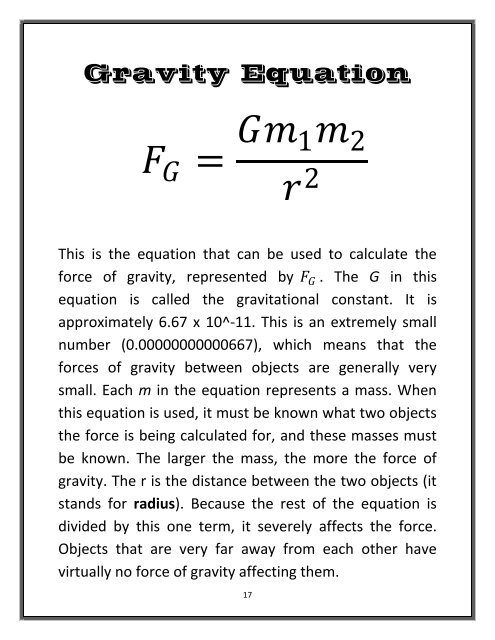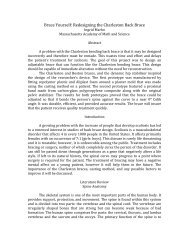The Basics of Newtonian Mechanics - the Scientia Review
The Basics of Newtonian Mechanics - the Scientia Review
The Basics of Newtonian Mechanics - the Scientia Review
You also want an ePaper? Increase the reach of your titles
YUMPU automatically turns print PDFs into web optimized ePapers that Google loves.
Gravity Equation<br />
F G = Gm 1m 2<br />
r 2<br />
This is <strong>the</strong> equation that can be used to calculate <strong>the</strong><br />
force <strong>of</strong> gravity, represented by F G . <strong>The</strong> G in this<br />
equation is called <strong>the</strong> gravitational constant. It is<br />
approximately 6.67 x 10^-11. This is an extremely small<br />
number (0.00000000000667), which means that <strong>the</strong><br />
forces <strong>of</strong> gravity between objects are generally very<br />
small. Each m in <strong>the</strong> equation represents a mass. When<br />
this equation is used, it must be known what two objects<br />
<strong>the</strong> force is being calculated for, and <strong>the</strong>se masses must<br />
be known. <strong>The</strong> larger <strong>the</strong> mass, <strong>the</strong> more <strong>the</strong> force <strong>of</strong><br />
gravity. <strong>The</strong> r is <strong>the</strong> distance between <strong>the</strong> two objects (it<br />
stands for radius). Because <strong>the</strong> rest <strong>of</strong> <strong>the</strong> equation is<br />
divided by this one term, it severely affects <strong>the</strong> force.<br />
Objects that are very far away from each o<strong>the</strong>r have<br />
virtually no force <strong>of</strong> gravity affecting <strong>the</strong>m.<br />
17
















